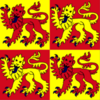Wales/History
| Faction Overview | Strategic Overview | History |
|---|
During the Dark Ages, the Saxons, Angles, Jutes and Frisians were colonising England and forced the Celts back to Kernow, Scotland and Wales. Wales contained several small kingdoms, although there were a few rulers, such as Rhodri the Great, who controlled nearly all of Wales. The separate kingdoms, with the help of the mountainous terrain, managed to hold the Germanic raiders at bay, although Kernow was soon lost.
Between a Hard Place and the Sea: The Rise of the Welsh Nation[edit | edit source]
Wales emerged as a nation from the collapse of Romano-British Britannia following the invasions of the Angles, Saxons and Jutes from the fifth century CE onwards. What is now known as Wales was for a time known as 'North Wales', while Devon and Kernow (now southwest England) were 'West Wales' until their conquest. The Mercian king Offa (Mercia equates roughly to the English Midlands) created an substantial earthwork, Offa's Dyke running between the Irish Sea and the Severn estuary in the later eighth century to separate his kingdom from Welsh lands. The dyke broadly marks the Anglo-Welsh boundary to this day.
Norman conquests[edit | edit source]
When the Normans invaded England in 1066, a new invasion of Wales was started. They settled mostly in the south of Wales, but their hold was tenuous at best. While the Normans drove out the king of Gwynedd in the north, Welsh resistance was centred in the west. In the 12th century, the situation reversed. The lords of Gwynedd returned from exile in Ireland and drove out the Normans, but the Welsh were fighting a losing battle against Norman power in the south. Soon, the lords of the south were of little importance, while the princes of Gwynedd would become the dominant figures in Welsh politics.
The Welsh ways of warfare were very different from those of the Normans; they used hit-and-run raids to lower morale, attacking supplies and lone troops, relying mostly on their infamous longbows and javelins. There was only one answer to this: building impregnable castles all over Wales to cement Norman power. The Welsh Wars, as they are called, saw Llywelyn II, prince of Gwynedd, pitted against King Edward I.
Wales Eclipsed[edit | edit source]
At first, the Welsh were fighting quite successfully against the English, but when Llywelyn II was killed in a skirmish, the Welsh cause collapsed. The remaining Welsh freedom fighters were captured and executed for treason, and the land annexed by 1283. Nevertheless, the Welsh held on to their identity. The English adopted their weapon, the longbow, and for centuries to come the Welsh would find profession mostly in English — later British — armies, while eventually a line of Welsh-born nobles, the Tudors, would be dominant in England during the early 16th century.
A major revolt against English rule was mounted in the early fifteenth century led by Owain Glyndwr, a member of the prosperous Welsh gentry who became embittered against the local English magnates for reasons which are uncertain, but probably owe as much to personal disputes as national sentiment. Glyndwr's rebellion achieved astonishing success, for a while. Beginning on Good Friday 1401, the rebels came to control much of the countryside and many Welsh towns, even advancing to Worcester in England. Glyndwr, who had been proclaimed Prince of Wales, held two parliaments at Machynlleth in mid Wales, and allied himself with the Duke of Northumberland and the Earl of Mortimer in a plan to dismember the English kingdom once Henry IV had been conclusively defeated. He made an alliance with France, and created two (short-lived) universities, one each in north and South Wales. However, by 1408 the tide had turned. His Northumbrian allies had been defeated and English forces retook many Welsh towns. The rebels resorted to guerilla warfare but by 1410 Glyndwr was a fugitive and he disappears from history, his fate a mystery.
Much as Owain Glyndwr emerged from the ranks of the Welsh gentry, so too did Henry Tudor, Earl of Richmond, who in 1485, as a somewhat tendentious claimant to the throne of England through the Lancastrian line, led an army of disaffected English magnates to victory over the Yorkist king Richard III at the Battle of Bosworth Field. Henry became King Henry VII and the progenitor of the Tudor dynasty, the first Welsh king of England. Henry's son, Henry VIII, completed the absorption of Wales into England in 1536, when the remaining parts of Wales were formally annexed to England and 'shired' - that is, divided into counties (shires) with sheriffs and lords lieutenant, rather than being ruled as marcher lordships.
References[edit | edit source]
- Age of Chivalry: Hegemony Wiki; Wales — A History

